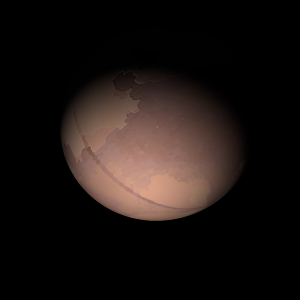|
|
Space Astro
|
Info for exoplanet "Peke"
| Scientific (actual) data |
|---|
| Name | LP 961-51 b |
| Planet status | Confirmed |
| Mass sini | 50 |
| Semi major axis | 5300 |
| Discovered | 2024 |
| Updated | 2024-06-30 |
| Publication | Published in a refereed paper |
| Detection type | Imaging |
| Alternate names | CWISE J115229.05-351105.9 |
| Star name | LP 961-51 |
| Right ascension | 178.15° |
| Declination | -35.16° |
| Mag v | 13.032 |
| Mag j | 9.391 |
| Mag h | 8.693 |
| Mag k | 8.503 |
| Star distance | 53.7094 |
| Star metallicity | -0.23 |
| Star mass | 0.5739 |
| Star radius | 0.5828 |
| Star sp type | M3V |
| Star age | 14 |
| Star temperature | 3474 |
| Wikipedia article | LP 961-51 b |
Back
| |
| Fictional info (?) |
|---|
| Suggested name | Peke |
| Planet type | Cold planet |
| The planet telescopically displays the complete range of phases, similar to Venus and the Moon, as it moves in its inner orbit relative to LP 961-51, which reoccurs over the so-called synodic period approximately every 64 days. |
| Atmosphere | Molecular hydrogen | 62% |
| Sulfur dioxide | 27% |
| Ammonia | 10% |
| Nitric oxide | 0.53% |
| Ethane | 0.2% |
| Atmospheric pressure | 80 bar |
 |
| No known satellites |
| Google search for Peke |
|
Website by Joachim Michaelis
|
|
|
|